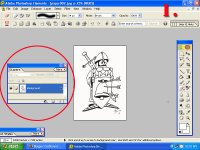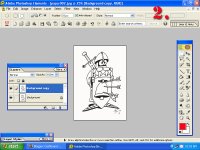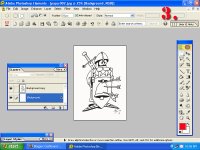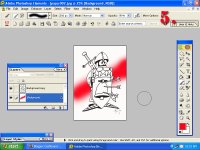





One of the biggest misunderstood feature in Photoshop is layers. It can appear very complicated but once it is explained, you will see that it is not very complicated and very useful. Layers permit you to do all kinds of fantastic stuff to an image.
For this purpose, I'll use a black and white copy of my Norman soldier drawing to illustrate this in a simple fashion.
Before we go off in the juicy stuff, let me give you a definition. Layers are used to give an image different levels on wich to work with. Imagine your image broken up into acetates on a projector. One could be the background, the second one a face and the third one would have some text. That's what layers are.
In photoshop, layers can be rearranged, there opacity modified, they can be copied, merged, locked with each other, created, deleted, you name it. There are two things to look for, the layer button on the top of the program window and the layer "toolbox" in the window.
Let's pic a jpg file in a folder an open it.
1. First step is to make 2 layers of this image. In the layer toolbox you'll notice that you have one layer named "background". Right click in the blue box that says "background" and click on "duplicate layer".
2. Second, now you have two layers. Click in the layer named "background" to select it, go to select/all and click on that. Now press "delete" to erase everything in your background layer.
3. Third step, you deleted the entire background but you still see the image! Your duplicate is on top of that layer and this is what you see. Your background being blank, you can now put stuff in there to show behind the soldier.
4. Fourth, now click in the "background copy" layer box to select it and with the magic wand I selected the white around the soldier to delete it. Even though it's white, it doesn't mean that it's transparent, you have to erase it. Remember that whatever you do happens in the layer that is selected, the one that is highlited in blue. You can also make a layer invisible by clicking on the eye in the box on the left. This helps sometimes, just click in it again for the layer to reappear.
5. Fifth, to drive the point home, I have made a brush stroke in the background layer to show you what the end result is. I will dump all kinds of stuff in that layer to make a background image for my soldier. Look in the background layer box and you will see one straight brush stroke, but in the image you only see what is not hidden by the soldiers layer.
6. Sixth, I've added some text to demonstrate that whenever you paste something or add some text, it automatically creates a new layer on top of the one that is selected. If I would have made the text with the background selected, the letters would have been between the soldier and the background. If you make the mistake, not to worry. Just go to layers/arrange/bring to front and it will go on top of the next layer.
Once you are done with your image, you can save it with all the separate layers in a psd file or you can go to layers/flatten image. This will return your image to one layer and you can save it as a jpg.
Remember to try stuff and make mistakes, lotsa of them. Success is a poor teacher.
Gerry
2 comments:
excellent blog and i will be adding a link to this at my store Adobe CS2 Photo Shop if thats ok with you. its a good source and link that would fit in nice with my adobe store :-)
Go right ahead. This poor blog is being left for granted and I have to add more stuff to it. Thank you for your comment.
Gerry
Post a Comment